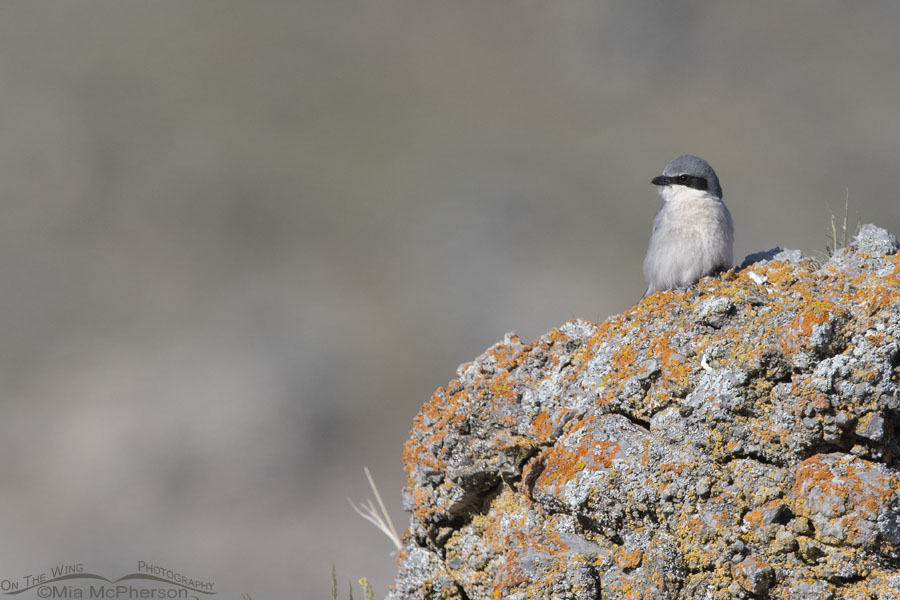 Loggerhead Shrike perched on a lichen covered rock – Nikon D500, f7.1, 1/2500, ISO 640, Nikkor 500mm VR with 1.4x TC, natural light
Loggerhead Shrike perched on a lichen covered rock – Nikon D500, f7.1, 1/2500, ISO 640, Nikkor 500mm VR with 1.4x TC, natural light
About two weeks ago I found an adult Loggerhead Shrike perched on a lichen covered rock in northern Utah a good distance from the road that I was on. This small raptor-wanna-be was busy calling and singing when I spotted it. Given that it is their breeding season here in Utah this shrike may have been trying to find a mate.
But will this shrike find a mate?
I have concerns about that. Since I moved to Utah in 2009 I have seen the numbers of Loggerhead Shrikes drop significantly. In areas where I used to see twenty to twenty-five Loggerhead Shrikes I am now lucky if I find even one. I work hard to find this species now. It wasn’t always that way.
Over the winter I may have photographed this particular shrike. It wasn’t all that far from where I consistently found a single Loggerhead Shrike throughout the coldest months of the year. That shrike was always alone. I never found another one nearby. There wasn’t another shrike near this one either.
Without any doubts I know that my observations of Loggerhead Shrikes are far fewer than they used to be and that I am not the only person who has wondered about a decline in their population in northern Utah. Other local birders and bird photographers have mentioned that they too are seeing fewer Loggerhead Shrikes than they used to see.
Seeing fewer Loggerhead Shrikes worries me. I wonder if they are being impacted by our drought and climate change or if both of those issues have caused a reduction in their prey in Utah. I truly don’t know. What I know is that there are fewer of them to be found in northern Utah than there were just five or six years ago.
And that isn’t good news.
According to allaboutbirds.org this species is in steep decline.
Loggerhead Shrikes are still fairly numerous in some areas (particularly the South and West), but their populations have fallen sharply. Between 1966 and 2015, the species declined by almost 3% per year, resulting in a cumulative decline of 76%, according to the North American Breeding Bird Survey.
The species’ decline coincides with the introduction and increased use of chemical pesticides between the 1940s and the 1970s, and may result in part from the birds’ ingestion of pesticide-laced prey from treated fields. Other likely causes of population decline include collision with vehicles, urban development, conversion of hayfields and pastureland, decimation of hedgerows, habitat destruction by surface-coal strip-mining, and altering of prey populations by livestock grazing.
In northern Utah unchecked urban sprawl, the use of pesticides and other habitat destruction may be only part of the cause for the decline in the numbers of Loggerhead Shrikes that I am seeing.
We need to do more to protect Loggerhead Shrikes, other birds and the entire natural world.
Now.
Mia
Click here to see more of my Loggerhead Shrike photos plus facts and information about this species.


Thank you for bringing some joy and wonder daily.
Good post, Mia.
Florida’s most recent breeding bird atlas, conducted from 2011-2016, showed similar declines for the Loggerhead Shrike. The counties I surveyed in central Florida showed steep declines for some counties but increases in adjacent counties. Some ornithologists speculate a shift in the population of this species due to most of the reasons you mention in your post. They simply moved to an area with more suitable habitat. The long-range effects of pesticides, poor land management, etc., will, of course, not be known until it may be too late.
Our “leaders”, not only in government, but education, urban planning, industry – all across the board – have failed our natural world in so many ways. Profit and power crush stewardship of the environment. In my opinion, the only solution is simultaneously working to evict the power brokers while finding a way to educate our children.
Thank you, Mia, for continuing to bring urgent concerns to the forefront through incredible images and intelligent discourse.
Insect numbers are dire.
The very efficient systemic “Neonicotinoid” insecticides have devastated that basis of the food web.
Heartrending. And true across the world – about so many species. Hiss and spit is the politest phrase I can muster.
I absolutely agree with you, we need to do more! However, I don’t have a good feeling that there are enough people in high places who will do something about this problem.
Maybe those people in high places ought to get down into the dirt to see what we are seeing instead of elevating themselves on their pedestals. A healthy planet means happy and healthy people.
Since moving to Utah in 2020, I have only seen two Loggerheads, and never two together. Growing up in Northern CA in the 70’s they were abundant, and I saw them all the time.
Kimberly, that is sad. Terribly sad.